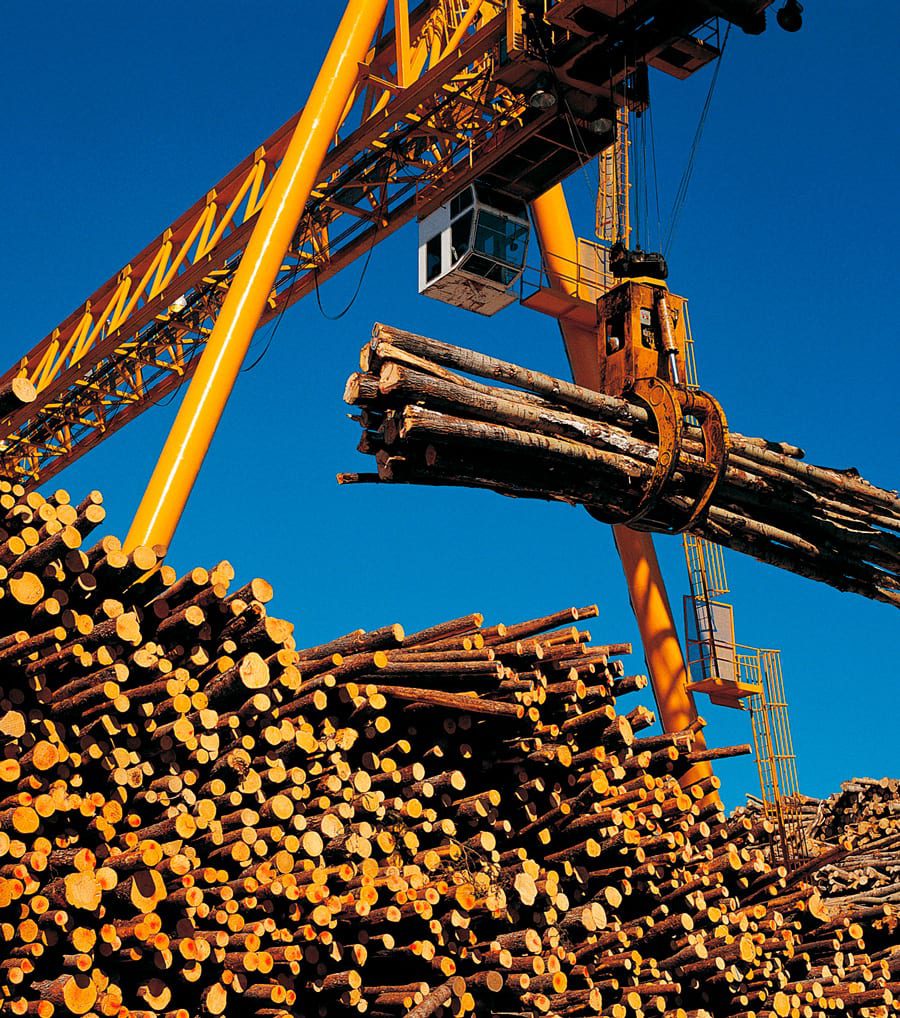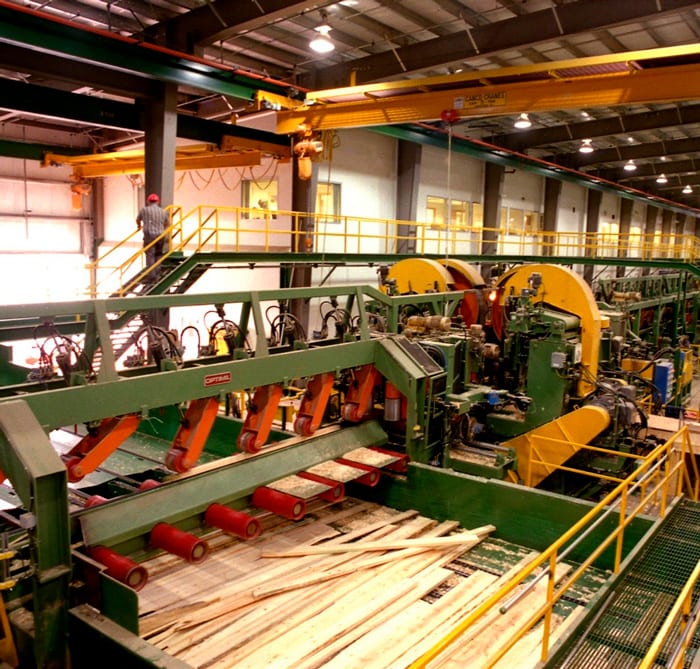Goals
- Enhance production efficiency with new computerized maintenance management system
Challenges
- Update outdated management system did not integrate the maintenance functions with plant purchasing systems, which required larger inventories of spares to be on hand
Results
- Diverse operations in both type and geography are now tied together
- Enhanced productivity through more efficient maintenance activities, helping to produce nearly 230 million square feet of plywood each year
- Achieved ISO 14001 certification at Williams Lake

``Many spare parts are no longer inventoried, but are simply ordered when a repair is scheduled and its work order is cut — which is a new capability that we gained, since the new system combines both work scheduling and parts purchasing.`` - Hank Dickey, Maintenance Superintendent
Background
Williams Lake, Canada – Weldwood of Canada Ltd. is one of North America’s leading producers of plywood and lumber products. To meet ever-increasing demand for the company’s products, this subsidiary of West Fraser Timber Co. Ltd. has made key investments in new technology in recent years to increase plant capacity at its facilities in western Canada. Weldwood’s Williams Lake plywood plant, located about 330 miles north of Vancouver, British Columbia, is a good example of how an asset management system can help management enhance both maintenance and production.
Project Scope
As part of its expansion program, Weldwood has done far more than just add capacity — management has also streamlined operations to make existing facilities run more efficiently. Among the tools used to enhance production efficiency are new computerized maintenance management systems (CMMS) that have been installed at several of its plants in British Columbia and Alberta. These systems have helped make the plants more productive by streamlining maintenance procedures so they are more efficient and take less time from production schedules to perform routine preventive maintenance (PM) or emergency repair services. In addition to increases in production equipment uptime, the CMMS has increased the efficiency of scheduled maintenance work and has reduced costs for spare parts inventories. At the same time, improved maintenance practices have also led to production of more consistent and uniformly high quality wood products.
The Williams Lake plywood plant, located about 330 miles north of Vancouver, British Columbia, is a good example of how an asset management system can help management enhance both maintenance and production. The company previously had used a mainframe computing system for managing maintenance planning functions, but the system was outdated. One of the main challenges was that it did not integrate the maintenance functions with plant purchasing systems, which made it cumbersome for automating purchasing paperwork in ordering parts, which in turn required larger inventories of spares to be on hand.
Weldwood management reviewed several CMMS and selected the AVEVA Enterprise Asset Management solution. The company’s maintenance management team conducted extensive maintenance assessments prior to installation in order to be sure their processes were optimized. They installed the AVEVA solution first at the Williams Lake plant. Based on initial experience with the installation here, they then rolled it out to five additional plants in just over one year.

Integrating Multiple-Site Maintenance
The AVEVA solution is now integrated tightly with all aspects of solid wood products manufacturing at plants in Williams Lake, Quesnel, 100 Mile House, Houston, Burns Lake and at Hinton, Alberta. It is used to track equipment and asset utilization, schedule manpower for maintenance and repair services, track and manage parts inventories and disbursements, and generate work orders automatically for preventive maintenance (PM) and on-demand for emergency repairs.
The AVEVA solution provides features that enable Weldwood management to tie together operations that are diverse in type and geography. It uses an “entity” concept to facilitate recording of costing and maintenance activity records for anything users wish to track. “Parent-child” relationships can be set up easily to build hierarchies for cost rollups and operating statistics. Work management features ensure that maintenance personnel have control of incoming work while providing a flexible way to track work in progress. Planning functions include information on labor, materials, tools, drawings, and instructions, plus subcontractor requirements, and this detail can be included on work orders. PM functions can be structured in libraries of standard jobs with automatic work order generation, inspection checklists, PM routine specs, and parts lists.
Using the detailed equipment information history that is developed via day-to- day activities, supervisors can analyze failure histories, track failure causes, and take action accordingly. Maintenance parts inventories can be better managed, especially when dealing with large numbers of unique and low unit value items that can often be subject to unpredictable demand. Workflow can be better planned and purchasing and procurement functions can be tied directly into maintenance programs.
Don Gibson, Mobile Equipment Supervisor, said, “We monitor odometer readings and fuel consumption statistics on all the trucks and mobile equipment, and we track actual hours of equipment operation in the plants. We enter weekly readings into the AVEVA solution, and the program tracks the average use of each machine, then predicts and schedules PM based on that data.”
The AVEVA solution database that facilitates maintenance planning at Williams Lake is designed to handle data on equipment usage from large entities down to the smallest — from division-level entities down to departments, then machinery type and parts lists. The database has 2,365 entities defined, with 4,615 inventory items in the catalogue that identifies specific equipment. The master purchasing catalogue has 66 parts lists with a total of more than 15,000 items that can be generated instantly on a work order, for any repair. About 115 PM jobs are predefined in the system, with nearly 1,200 PM tasks and 240 safety procedures. Similar databases are maintained for five other Weldwood plants, and coordinated and monitored at head offices in Vancouver.

Enhancing Production Efficiency
The AVEVA solution has become a valuable tool for Weldwood because it has helped the company enhance productivity through more efficient maintenance activities. This is critical for managing service of sophisticated equipment so that production keeps humming at the Williams Lake plywood plant. This single plant produces nearly 230 million square feet of plywood each year from spruce, pine, and fir logs brought in from Crown lands throughout British Columbia.
According to Rick Brandson, Maintenance Supervisor, “We have a maintenance meeting every Thursday to schedule our PM and other service. The normal window is seven hours, but if we need more time we can add to it as needed. It’s all based on production needs. We know ahead of time when we have bigger jobs. We then adjust those maintenance windows accordingly so we can minimize the impact on production.”
The new system has been an important tool in Weldwood’s achievement of ISO 14001 certification at Williams Lake. It helped the company meet stringent audit requirements for environmental systems because of the performance audit trail it provides on all equipment and maintenance operations.
The plant is just about 100% self-sufficient, almost a perfect balance of incoming and outgoing materials — for both fuel purposes and environmental issues. The bark and waste are used to produce heat for drying lumber as well as for heating buildings. The only exception is in the summertime, when there may be a bit of excess waste, so the chips are trucked to a Northwest energy plant that burns it to generate steam, producing power for British Columbia Hydro.
The AVEVA solution has also proven to be a valuable tool to help Weldwood maintenance management achieve a good return on investment at Williams Lake.